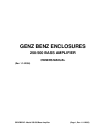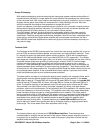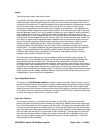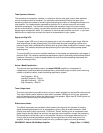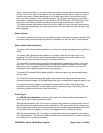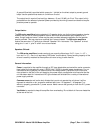GENZ BENZ - Model 250/500 Bass Amplifier (Page 2, Rev: 1/14/2006)
Design Philosophy -
With experience designing and manufacturing both bass guitar speaker cabinets and amplifiers, it
became obvious that there is a large market for a bass amplifier that reproduces the natural tones
of the instrument itself. With many amplifier manufacturers hyping their “distinctive” sound, it seems
forgotten that the player has chosen his instrument for it’s feel, playability and tone. Why then,
should the amplifier manufacturer feel compelled to change this sound?
As with our speakers, Genz Benz amplifiers strive to maximize your instrument’s natural tone and
feeling without imparting additional coloration. This resulting sound will not become obsolete with
changing fads but will always be true to your instrument’s natural qualities.
The circuit design, features, physical construction and speaker selection have been carefully
calculated to give you, the experienced player, the best performance and value in bass guitar
amplification. Featuring sturdy jacks and controls, blendable Tube-Fet front end, a balanced direct
output and an industrial duty bipolar power amplifier with toroidal power transformer, the Genz
Benz 250/500 series bass amplifiers and combos will give you the tools necessary to sound your
very best on stage.
Technical Stuff -
The first stage of the 250/500 preamp uses a low noise bi-fet linear scaling amplifier with a low cut
point at 23 Hz to prevent excessive speaker cone excursion and intermodulation distortion. There
is a smooth first order high pass boost network starting at approx. 2.5kHz with a passband gain
limit of 6 dB. Additional bandwidth roll-off is provided at 20 kHz for RFI suppression. The variable
gain stages are a feedback-divider type control, one of which is all solid state and the other utilizing
a cathode follower (tube) each providing a maximum gain of about 30 dB. On the tube stage,
variable non-linear loading creates a smooth and natural sounding overdrive rich in second
harmonics. These blendable gain stages feed the 4 band active equalizer which is composed of 4
discrete bandpass filters combined in a current summing arrangement. These filters provide 9 dB
of boost and cut, with center position flat. The output amplifier feeds the master volume control and
fully protected power amplifier. A low noise differential output amplifier is provided for the direct
output (switchable pre/post eq) and is phantom power protected.
The power section consists of a low distortion bipolar power amplifier with integrated limiter which
allows gradual overload without sudden loss of feedback control of the speakers. In the model
250, output is rated at 175 watts RMS at 8 ohms and 250 watts RMS at 4 ohms. In the model 500,
output is rated at 275 watts RMS at 8 ohms, 400 watts RMS at 4 ohms and 525 watts RMS at 2
ohms. The amplifier topology is low feedback class A-B with servo control of bias and DC offset.
Also provided is on board output limiting, dual slope integrated VI limiting, solid state thermal
protection, short circuit load protection, dc fault protection and RFI suppression. All amplifier status
points are indicated on a dual color led array.. This amplifier uses heavy duty copper based polar
power transistors directly mounted to a hefty extruded aluminum heatsink. The output section
sports a combined rating of 1600 watts and 128 amps to insure a conservative and reliable design.
An important and not commonly discussed specification is the power amplifier’s ability to deliver
rated power into a reactive load. All speakers present a reactive load to the amplifier which
reduces real world driving ability. The power sections of all model 250 and 500 amplifiers are
rated to deliver full power into a reactive load with a 45 degree (leading or lagging) power factor
phase angle. This is one reason Genz Benz amplifiers sound so big.
Features -
The following feature set is included on all 250/500 Bass Amplifiers. These features were
included based on usability and are the result of the input of veteran players around the country. It
is important for an amplifier to reflect the real needs of the players using them. We feel that this
amplifier series does just that.



